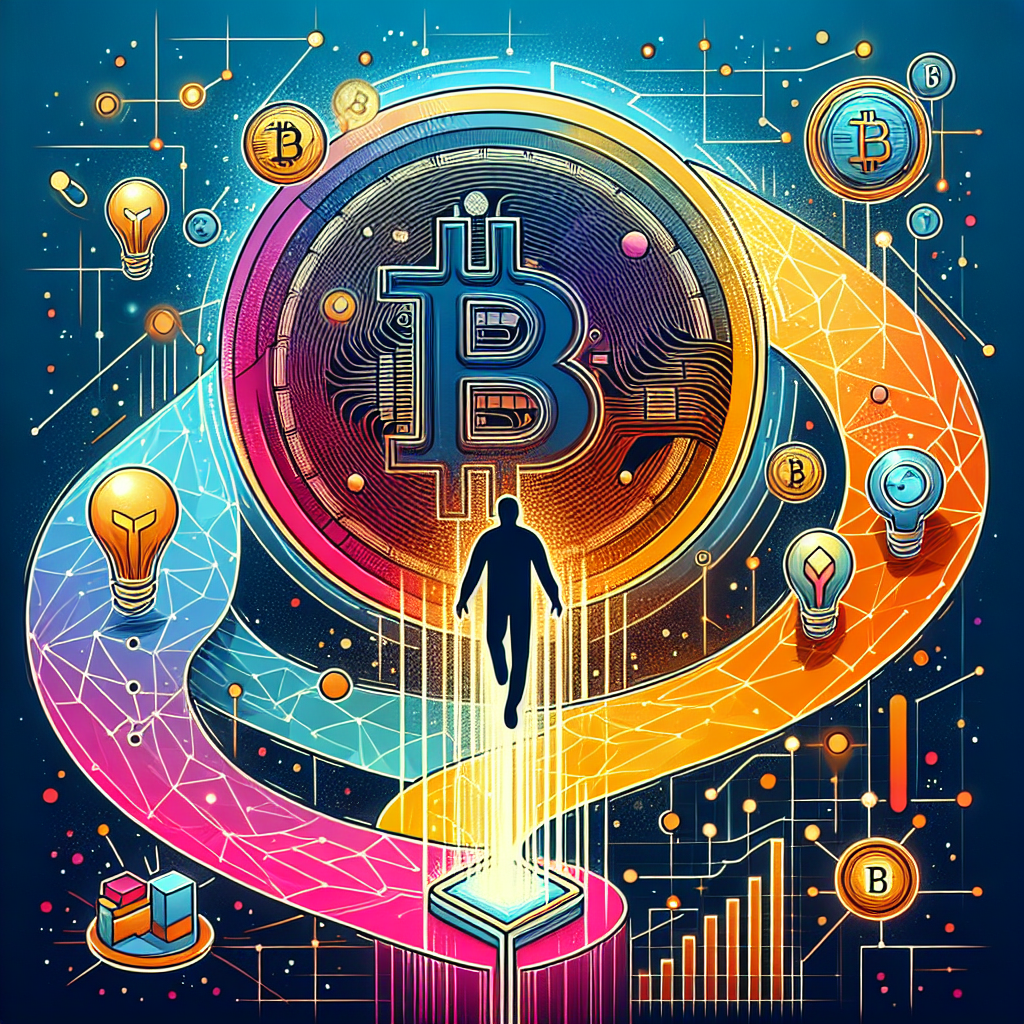Revolutionizing User Onboarding: Sam Altman’s Worldcoin Introduces Layer 2 Blockchain
In the ever-evolving world of cryptocurrency, innovation and improvement are constant goals. One name that has been making waves in this space is Sam Altman, the renowned entrepreneur and former president of the prestigious startup accelerator, Y Combinator. Altman has recently announced the launch of Worldcoin, a new cryptocurrency project aimed at revolutionizing user onboarding through the use of layer 2 blockchain technology.
In this article, we will delve into the details of Worldcoin’s layer 2 blockchain and how it is set to enhance the user onboarding experience. We will explore the challenges faced by existing blockchain networks in terms of scalability and usability, and how Altman’s project aims to overcome these hurdles. Additionally, we will examine the potential impact of Worldcoin’s layer 2 blockchain on the wider cryptocurrency industry and its implications for mainstream adoption.
Key Takeaways:
1. Sam Altman, the former president of Y Combinator, is launching Worldcoin, a new cryptocurrency that aims to improve user onboarding and accessibility.
2. Worldcoin plans to introduce a Layer 2 blockchain solution that will address the challenges of existing blockchain networks, such as high transaction fees and slow confirmation times.
3. The Layer 2 blockchain will utilize a combination of off-chain and on-chain technologies to enhance scalability and reduce costs, making it easier for users to participate in the network.
4. Worldcoin’s unique approach involves using a global network of biometrically verified individuals, called “validators,” who will be rewarded with Worldcoin tokens for their participation in the network.
5. The project’s vision is to create a more inclusive and decentralized financial system by making cryptocurrency accessible to people around the world, regardless of their technical expertise or access to traditional banking services.
Controversial Aspect 1: Centralization Concerns
One of the most controversial aspects surrounding the launch of Sam Altman’s Worldcoin Layer 2 blockchain is the concern over centralization. Altman’s vision for Worldcoin involves a unique approach to user onboarding, where every person on the planet is given a share of the cryptocurrency by scanning their irises. While this may seem like an inclusive and egalitarian approach, critics argue that it raises serious questions about privacy and control.
By requiring individuals to scan their irises, Worldcoin would have access to highly sensitive biometric data, raising concerns about the potential for abuse and surveillance. This centralized control over user data goes against the core principles of decentralization that blockchain technology was built upon. Skeptics argue that such a system could be exploited by governments or other powerful entities to monitor and control individuals, undermining the very essence of a decentralized blockchain.
However, proponents of Worldcoin argue that the intention behind the iris scanning is to ensure that the cryptocurrency is distributed fairly and to prevent fraudulent activity. They argue that by using a biometric identifier like the iris, it becomes extremely difficult for individuals to create multiple accounts or engage in identity theft. They believe that this approach will lead to a more inclusive and accessible financial system, particularly for those who are unbanked or marginalized.
Controversial Aspect 2: Ethical Implications
Another controversial aspect surrounding the launch of Worldcoin’s Layer 2 blockchain is the ethical implications of incentivizing people to scan their irises in exchange for cryptocurrency. Critics argue that this approach commodifies personal biometric data and may lead to a slippery slope where individuals are encouraged to trade their privacy for financial gain.
There are concerns that this model could set a precedent for the monetization of personal data, further eroding privacy rights and individual autonomy. The potential for abuse and misuse of such sensitive information raises questions about the long-term consequences of incentivizing individuals to share their biometric data for financial gain.
On the other hand, supporters argue that Worldcoin’s approach is voluntary and transparent. They emphasize that individuals have the choice to participate or not, and that the benefits of financial inclusion and accessibility outweigh the potential ethical concerns. They believe that by leveraging biometric data, Worldcoin can create a more secure and fraud-resistant system that benefits the global population.
Controversial Aspect 3: Technological Feasibility
One of the key controversial aspects of Worldcoin‘s Layer 2 blockchain is the question of its technological feasibility. Altman’s vision of including every person on the planet in the cryptocurrency ecosystem is ambitious, to say the least. Skeptics argue that the infrastructure required to scan and verify the irises of billions of people is a monumental task that may not be achievable in practice.
There are concerns about the scalability of such a system, as well as the potential for errors and false positives in iris scanning technology. Critics argue that the technology may not be mature enough to handle the massive scale that Worldcoin envisions, leading to potential security vulnerabilities and a lack of trust in the system.
Proponents of Worldcoin, however, believe that technological advancements in iris scanning and blockchain technology will make this vision a reality. They argue that the rapid pace of innovation in these fields, coupled with the financial resources and expertise of the Worldcoin team, will overcome any technical challenges. They believe that with proper investment and development, the Layer 2 blockchain can be successfully implemented on a global scale.
1. The Vision Behind Sam Altman’s Worldcoin
Sam Altman, the former President of Y Combinator, has embarked on a new venture called Worldcoin with the aim of creating a global digital currency that is accessible to anyone, regardless of their location or socioeconomic status. Altman’s vision is to build a decentralized financial system that empowers individuals and eliminates barriers to financial inclusion.
2. Introducing Layer 2 Blockchain
Worldcoin plans to launch a Layer 2 blockchain solution to improve user onboarding and address the scalability challenges faced by existing blockchain networks. Layer 2 solutions are designed to enhance the performance and efficiency of the underlying blockchain by offloading certain tasks to a secondary layer, while still maintaining the security and decentralization of the main blockchain.
3. Enhancing User Onboarding Experience
One of the primary goals of Worldcoin’s Layer 2 blockchain is to improve the user onboarding experience, making it easier for individuals to join the network and transact with the digital currency. Traditional blockchain networks often require users to navigate complex processes, such as setting up wallets, managing private keys, and understanding technical jargon. Worldcoin aims to simplify these steps and provide a user-friendly interface that lowers the entry barriers.
4. Leveraging Identity Verification
To ensure the integrity of its network and comply with regulatory requirements, Worldcoin plans to leverage identity verification as part of its user onboarding process. By implementing robust identity verification protocols, Worldcoin aims to prevent fraudulent activities and ensure that users are genuine individuals. This approach can help build trust in the network and reduce the risks associated with money laundering or other illicit activities.
5. Global Accessibility and Inclusion
Worldcoin’s Layer 2 blockchain aims to make digital currency accessible to individuals around the world, including those who may not have access to traditional banking services. By leveraging blockchain technology, Worldcoin can overcome geographical barriers and provide financial services to the unbanked or underbanked populations. This can have a profound impact on economic empowerment and financial inclusion, particularly in developing countries.
6. Scalability and Transaction Speed
Scalability has been a significant challenge for many blockchain networks, leading to slow transaction speeds and high fees during peak usage periods. Worldcoin’s Layer 2 blockchain aims to address these scalability issues by offloading some of the transaction processing to the secondary layer. This approach can significantly increase the transaction throughput and reduce confirmation times, making the network more efficient and user-friendly.
7. Potential Impact on Existing Blockchain Ecosystems
Worldcoin’s launch of a Layer 2 blockchain solution could have a significant impact on existing blockchain ecosystems. While the primary focus is on improving user onboarding, the scalability enhancements and user-friendly experience offered by Worldcoin’s Layer 2 blockchain may attract users and developers away from other networks. This could lead to increased competition and potentially drive innovation in the blockchain industry as a whole.
8. Challenges and Risks
While Worldcoin’s vision and the launch of a Layer 2 blockchain are promising, there are several challenges and risks that need to be considered. One of the key challenges is ensuring the security and integrity of the network, especially when dealing with large-scale adoption. Additionally, regulatory compliance and navigating the complex legal landscape surrounding digital currencies can pose risks. Worldcoin will need to address these challenges effectively to achieve its goals.
9. Partnerships and Collaborations
Worldcoin understands the importance of collaboration and partnerships in achieving its vision. The company has been actively seeking collaborations with various organizations, including academic institutions, non-profit organizations, and industry leaders. These partnerships can provide valuable expertise, resources, and support in areas such as technology development, research, and community engagement.
10. The Future of Worldcoin
As Worldcoin prepares to launch its Layer 2 blockchain, the future looks promising for this ambitious project. With a strong vision, focus on user onboarding, and scalability enhancements, Worldcoin has the potential to revolutionize the way we think about global digital currencies. The success of Worldcoin will depend on its ability to overcome challenges, build partnerships, and gain widespread adoption. Only time will tell if Worldcoin can achieve its goals and make a lasting impact on the world of finance.
The Emergence of Cryptocurrencies
In 2008, an anonymous person or group of people known as Satoshi Nakamoto introduced Bitcoin, the world’s first decentralized cryptocurrency. This groundbreaking technology, based on blockchain, offered a new way to transfer and store value without the need for intermediaries like banks. Bitcoin’s success paved the way for the emergence of numerous other cryptocurrencies, each with its own unique features and use cases.
The Rise of Layer 2 Solutions
As the popularity of cryptocurrencies grew, so did the demand for faster and more scalable blockchain networks. Traditional blockchains, like Bitcoin and Ethereum, faced challenges in terms of transaction speed and scalability, making them less suitable for mass adoption. This led to the development of layer 2 solutions, which aim to improve the efficiency and scalability of existing blockchains.
Layer 2 solutions work by building on top of existing blockchains and handling transactions off-chain, reducing the burden on the main blockchain. This allows for faster and cheaper transactions, making it more feasible for everyday use. These solutions come in various forms, such as payment channels, sidechains, and state channels, each offering different trade-offs between security, decentralization, and scalability.
The Need for Improved User Onboarding
While cryptocurrencies have gained significant traction in recent years, user onboarding remains a significant barrier to mainstream adoption. The process of acquiring and using cryptocurrencies can be complex and intimidating for newcomers, often requiring technical knowledge and multiple steps to set up a wallet and make transactions.
Recognizing this challenge, Sam Altman, the former president of Y Combinator, announced the development of Worldcoin, a layer 2 blockchain designed to improve user onboarding. Altman aims to create a more user-friendly and accessible cryptocurrency experience, making it easier for anyone to participate in the digital economy.
Worldcoin’s Layer 2 Blockchain
Worldcoin’s layer 2 blockchain is built on top of the Ethereum network, leveraging its security and existing infrastructure. The project aims to address the scalability issues of Ethereum by processing transactions off-chain, while still ensuring the security and trustlessness of the underlying blockchain.
One of the key features of Worldcoin is its focus on user onboarding. Altman plans to achieve this by creating a decentralized identity system that allows users to easily create and manage their digital identities. This would eliminate the need for complex wallet setups and private key management, simplifying the process for new users.
Additionally, Worldcoin intends to implement a universal basic income (UBI) system, distributing a small amount of cryptocurrency to every person in the world. This ambitious goal aims to address wealth inequality and provide economic opportunities to individuals who may not have access to traditional financial systems.
Challenges and Future Outlook
While Worldcoin’s vision of improving user onboarding and promoting financial inclusion is commendable, the project faces several challenges. One of the main concerns is the centralization of power, as Worldcoin plans to distribute its cryptocurrency based on biometric data, potentially raising privacy and security issues.
Moreover, the success of Worldcoin relies on widespread adoption and acceptance, which may be challenging in a highly competitive cryptocurrency landscape. The project will need to overcome technical hurdles, build partnerships, and gain the trust of users to achieve its goals.
Despite these challenges, Worldcoin represents an important step towards making cryptocurrencies more accessible and user-friendly. By addressing the barriers to entry, such as complex onboarding processes, Altman’s project has the potential to bring cryptocurrencies closer to mainstream adoption.
FAQs
1. What is Worldcoin’s Layer 2 Blockchain?
Worldcoin’s Layer 2 Blockchain is a secondary protocol built on top of an existing blockchain network. It aims to improve user onboarding by enhancing scalability, reducing transaction costs, and increasing network speed.
2. How does Layer 2 technology improve user onboarding?
Layer 2 technology allows for off-chain processing of transactions, which reduces congestion on the main blockchain and improves scalability. By moving some transactions off-chain, user onboarding becomes faster and more cost-effective.
3. What are the benefits of Worldcoin’s Layer 2 Blockchain?
Worldcoin’s Layer 2 Blockchain offers several benefits, including faster transaction confirmation times, lower fees, improved scalability, and enhanced user experience. These advantages make it easier for new users to join the network and participate in transactions.
4. How does Worldcoin plan to implement Layer 2 technology?
Worldcoin plans to implement Layer 2 technology by building a separate blockchain protocol that interacts with the main blockchain. This secondary protocol will handle certain transactions off-chain, reducing the load on the main network and improving user onboarding.
5. Will existing Worldcoin users need to migrate to the Layer 2 Blockchain?
Existing Worldcoin users will not need to migrate to the Layer 2 Blockchain. The Layer 2 technology will primarily benefit new users by providing a faster and more efficient onboarding process. However, existing users may also experience some improvements in transaction speed and cost.
6. How will the Layer 2 Blockchain impact transaction fees?
The Layer 2 Blockchain is expected to reduce transaction fees by moving some transactions off-chain. By processing these transactions outside the main blockchain, the Layer 2 solution can significantly lower fees, making it more affordable for users to participate in the network.
7. Will the Layer 2 Blockchain compromise the security of Worldcoin?
No, the Layer 2 Blockchain will not compromise the security of Worldcoin. While it introduces a secondary protocol, the main blockchain’s security measures will still be in place. Additionally, Worldcoin will implement robust security measures for the Layer 2 solution to ensure the integrity of transactions.
8. When will Worldcoin’s Layer 2 Blockchain be launched?
The exact launch date of Worldcoin’s Layer 2 Blockchain has not been announced yet. However, the project is currently in development, and the team aims to release it as soon as it is ready for deployment. Stay tuned for updates from Worldcoin regarding the launch.
9. Can other blockchain projects adopt Worldcoin’s Layer 2 technology?
While Worldcoin’s Layer 2 technology is specifically designed for its own blockchain network, other projects with similar requirements could potentially adopt similar solutions. The underlying principles of Layer 2 technology can be applied to various blockchain networks to improve scalability and user onboarding.
10. How will Worldcoin’s Layer 2 Blockchain impact the adoption of cryptocurrencies?
Worldcoin’s Layer 2 Blockchain has the potential to significantly impact the adoption of cryptocurrencies. By reducing transaction costs and improving user onboarding, it becomes easier for individuals and businesses to participate in the network. This increased accessibility can drive wider adoption of cryptocurrencies and contribute to their mainstream acceptance.
Common Misconceptions about
Misconception 1: Worldcoin’s Layer 2 blockchain is just another cryptocurrency
One common misconception about Worldcoin’s Layer 2 blockchain is that it is just another cryptocurrency. While it is true that Worldcoin is a digital currency, the Layer 2 blockchain it is built upon serves a much larger purpose. Worldcoin’s Layer 2 blockchain is designed to improve user onboarding, making it easier for people around the world to access and use cryptocurrencies.
The Layer 2 solution offered by Worldcoin is not focused on creating a new digital currency or competing with existing cryptocurrencies. Instead, it aims to address the challenges of onboarding new users into the world of cryptocurrencies. By providing a user-friendly and accessible platform, Worldcoin aims to make it easier for individuals to adopt and utilize digital currencies in their everyday lives.
Misconception 2: Worldcoin’s Layer 2 blockchain will centralize control
Another misconception surrounding Worldcoin’s Layer 2 blockchain is that it will centralize control over the cryptocurrency ecosystem. This misconception likely stems from concerns about the involvement of Sam Altman, a prominent figure in the tech industry, as well as the initial distribution method of Worldcoin.
However, it is important to note that Worldcoin’s Layer 2 blockchain is designed to be a decentralized network. The goal is to create a system that is accessible to everyone, regardless of their geographical location or socioeconomic status. While Sam Altman’s involvement may bring attention and resources to the project, the ultimate goal is to empower individuals and promote financial inclusivity.
The Layer 2 blockchain technology employed by Worldcoin is specifically designed to improve scalability and reduce transaction costs, making it more accessible to a wider audience. By leveraging the advantages of a Layer 2 solution, Worldcoin aims to create a decentralized ecosystem that benefits all participants.
Misconception 3: Worldcoin’s Layer 2 blockchain is a solution for all onboarding challenges
One misconception that needs to be clarified is that Worldcoin’s Layer 2 blockchain is a one-size-fits-all solution for all onboarding challenges in the cryptocurrency space. While the Layer 2 blockchain technology has the potential to improve user onboarding, it is not a panacea for all the complexities associated with entering the cryptocurrency market.
Worldcoin’s Layer 2 blockchain primarily focuses on enhancing accessibility and usability for individuals who are new to cryptocurrencies. It aims to simplify the onboarding process and make it easier for people to start using digital currencies. However, it does not address all the regulatory, educational, and infrastructure challenges that exist in the cryptocurrency ecosystem.
It is important to recognize that improving user onboarding is just one aspect of the broader goal of mainstream adoption of cryptocurrencies. While Worldcoin’s Layer 2 blockchain may contribute to this goal, it is essential to address other critical factors such as regulatory frameworks, educational initiatives, and infrastructure development to achieve widespread adoption.
By dispelling these common misconceptions about Worldcoin’s Layer 2 blockchain, we can gain a clearer understanding of its purpose and potential impact. Worldcoin’s Layer 2 blockchain is not just another cryptocurrency, but a solution aimed at improving user onboarding. It seeks to create a decentralized ecosystem that benefits all participants, while also acknowledging that it is not a one-size-fits-all solution for all onboarding challenges. As the cryptocurrency industry continues to evolve, it is crucial to critically evaluate new developments and separate facts from misconceptions.
Concept 1: Layer 2 Blockchain
A layer 2 blockchain is a technology that is built on top of an existing blockchain network, like Ethereum or Bitcoin, to improve its performance and scalability. It acts as a secondary layer that processes transactions and stores data, while still benefiting from the security and decentralization of the main blockchain.
Think of the main blockchain as a busy highway with limited capacity. As more people start using it, the traffic becomes congested, causing delays and higher fees. Layer 2 blockchains, on the other hand, are like additional lanes built alongside the highway. They help distribute the load and allow more transactions to be processed quickly and at a lower cost.
By launching a layer 2 blockchain, Worldcoin aims to address the challenges of onboarding new users onto their platform. It will enable faster and more efficient transactions, making it easier for people to join and use Worldcoin’s network.
Concept 2: User Onboarding
User onboarding refers to the process of getting new users to sign up and start using a particular platform or service. It involves creating an account, providing necessary information, and familiarizing users with the platform’s features and functionalities.
In the context of Worldcoin, user onboarding is crucial for the adoption and growth of their network. To attract more users, they need to make the onboarding process as simple and seamless as possible. This includes reducing the time it takes to create an account, verifying user identities, and enabling smooth transactions.
By launching a layer 2 blockchain, Worldcoin aims to improve user onboarding by offering faster transaction processing and lower fees. This means new users can sign up and start using Worldcoin’s platform more quickly and easily, without facing the delays and high costs often associated with traditional blockchains.
Concept 3: Blockchain Scalability
Blockchain scalability refers to the ability of a blockchain network to handle an increasing number of transactions as its user base grows. Traditional blockchains, like Bitcoin and Ethereum, face challenges in scaling due to their limited processing capacity and the time it takes to validate and confirm transactions.
Imagine a popular social media platform where millions of users post updates, photos, and videos every second. If the platform’s infrastructure cannot handle such a high volume of data, it will become slow and unresponsive, frustrating users and hindering its growth.
Worldcoin’s layer 2 blockchain aims to improve scalability by offloading a significant portion of the transaction processing to the secondary layer. This means that more transactions can be processed simultaneously, reducing congestion and allowing the network to handle a larger number of users and transactions.
With improved scalability, Worldcoin can accommodate a growing user base without sacrificing speed or increasing transaction costs. This is essential for the long-term success and adoption of their blockchain platform.
Sam Altman’s Worldcoin is set to revolutionize user onboarding with the launch of its layer 2 blockchain. The platform aims to address the challenges of scalability, speed, and cost that have hindered the widespread adoption of cryptocurrencies. By leveraging layer 2 technology, Worldcoin can process transactions off-chain, significantly reducing congestion on the main blockchain and improving user experience.
The layer 2 blockchain will also enable seamless integration with existing applications and platforms, making it easier for users to onboard and transact with Worldcoin. This innovative approach not only enhances the user experience but also opens up new possibilities for developers to build decentralized applications on top of the Worldcoin network. With Sam Altman’s track record of success and the team’s expertise, Worldcoin has the potential to become a major player in the cryptocurrency space.




